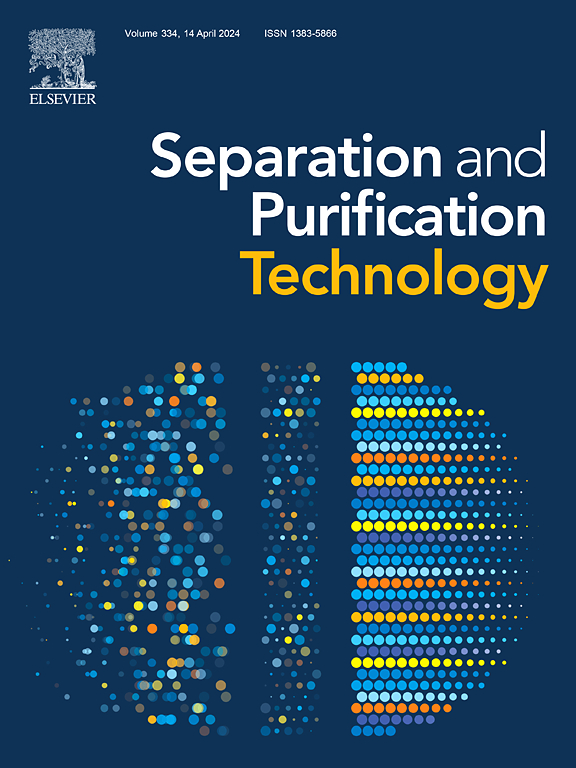Facile supersaturation control strategies for regulating nucleation and crystal growth in membrane crystallisation
IF 8.1
1区 工程技术
Q1 ENGINEERING, CHEMICAL
引用次数: 0
Abstract
The integration of crystallisation into membrane distillation has been proposed for brine mining as a method to effectively control primary nucleation which uses the excess supersaturation to create a new crystal phase. However, primary nucleation desaturates the solvent, subsequently introducing competition between crystal growth and nucleation mechanisms, which must be regulated to achieve a high yield and good product quality. This study therefore investigated supersaturation control strategies that can regulate nucleation and crystal growth mechanisms in membrane distillation crystallisation (MDC) following induction. Membrane area was used to adjust supersaturation, as this can modify kinetics without introducing changes to mass and heat transfer within the boundary layer. An increase in concentration rate shortened induction time and raised supersaturation at induction. This broadened the metastable zone width, and reduced scaling, due to the increased supersaturation driving force which favours a homogeneous primary nucleation pathway. Modulating supersaturation also repositioned the system within specific regions of the metastable zone that can favour crystal growth versus primary nucleation. Scaling was further mitigated using in-line filtration to ensure crystal retention within the crystalliser to reduce deposition. This permitted a consistent supersaturation rate to be sustained, enabling a longer hold-up time following induction. Population balance confirmed a reduction in nucleation rate with longer hold-up times, due to the desaturation of the solvent caused by crystal growth which resulted in larger crystal sizes. Through segregating the crystal phase into the bulk solution, growth can be more closely controlled to improve habit, shape and purity, independent of nucleation, due to the development of two discrete regions of supersaturation. The supersaturation control strategies described herein are unique to MDC and address the acknowledged challenge of supersaturation control within existing industrial evaporative crystalliser design.调节膜结晶成核和晶体生长的简单过饱和控制策略
在卤水开采中,人们提出将结晶与膜蒸馏相结合,作为一种有效控制原生成核的方法,即利用过量过饱和度产生新的结晶相。然而,初生成核使溶剂脱饱和,随后在晶体生长和成核机制之间引入竞争,必须对其进行调节,以实现高收率和良好的产品质量。因此,本研究探讨了过饱和控制策略,可以调节诱导后膜蒸馏结晶(MDC)的成核和晶体生长机制。膜面积用于调节过饱和,因为这可以改变动力学,而不会改变边界层内的质量和传热。浓度速率的增加缩短了诱导时间,提高了诱导时的过饱和度。这扩大了亚稳区宽度,减少了结垢,因为过饱和驱动力的增加有利于均匀的原生成核途径。调制过饱和也将系统重新定位在亚稳区的特定区域,有利于晶体生长而不是初成核。使用在线过滤进一步减轻结垢,以确保结晶器内的晶体保留,以减少沉积。这允许维持一致的过饱和速率,使诱导后的保持时间更长。种群平衡证实,随着保持时间的延长,成核速率降低,这是由于晶体生长引起的溶剂去饱和导致晶体尺寸增大。通过将晶体相分离到体溶液中,可以更紧密地控制生长,以改善习性、形状和纯度,而不依赖于成核,因为两个离散的过饱和区域的发展。本文描述的过饱和控制策略是MDC独有的,并解决了现有工业蒸发结晶器设计中过饱和控制的公认挑战。
本文章由计算机程序翻译,如有差异,请以英文原文为准。
求助全文
约1分钟内获得全文
求助全文
来源期刊

Separation and Purification Technology
工程技术-工程:化工
CiteScore
14.00
自引率
12.80%
发文量
2347
审稿时长
43 days
期刊介绍:
Separation and Purification Technology is a premier journal committed to sharing innovative methods for separation and purification in chemical and environmental engineering, encompassing both homogeneous solutions and heterogeneous mixtures. Our scope includes the separation and/or purification of liquids, vapors, and gases, as well as carbon capture and separation techniques. However, it's important to note that methods solely intended for analytical purposes are not within the scope of the journal. Additionally, disciplines such as soil science, polymer science, and metallurgy fall outside the purview of Separation and Purification Technology. Join us in advancing the field of separation and purification methods for sustainable solutions in chemical and environmental engineering.
 求助内容:
求助内容: 应助结果提醒方式:
应助结果提醒方式:


